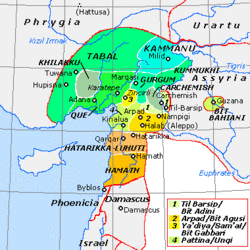

Gurgum
Kurkuma
| |||||||||
|---|---|---|---|---|---|---|---|---|---|
| Unknown–711 BC | |||||||||

Gurgum and its capital Marqas(i) among the Neo-Hittite states
| |||||||||
| Capital | Marqas (modern-day Kahramanmaraş, Turkey) | ||||||||
| Common languages | Hieroglyphic Luwian | ||||||||
| Religion | Luwian religion | ||||||||
| Government | Monarchy | ||||||||
| Historical era | Iron Age | ||||||||
• Established | Unknown | ||||||||
• Disestablished | 711 BC | ||||||||
| |||||||||
| Today part of | Turkey | ||||||||
Gurgum was a Neo-Hittite state in Anatolia, known from the 10th to the 7th century BC. Its name is given as Gurgum in Assyrian sources,[1] while its native name seems to have been Kurkuma for the reason that the capital of Gurgum—Marqas in Assyrian sources (today Maraş)—was named "the Kurkumaean city"[2] (ku+ra/i-ku-ma-wa/i-ni-i-sà(URBS)[3]) in local Hieroglyphic Luwian inscriptions.
The first historical event in the history of Gurgum is known for the reign of Larama I c. 950 BC. This Gurgumaean king undertook a program of reconstruction including the replanting of crops and vineyards.[4]
In 858 BC, during the first western campaign of the Assyrian king Shalmaneser III, king Muwatalli II of Gurgum submitted to the Assyrians and paid them tribute. This tribute consisted of gold, silver, oxen, sheep, wine, and his own daughter with her dowry.[5]
Muwatalli II's son, King Halparuntiya II, undertook several military expeditions. He attacked the city (or land?) of Hirika (probably to be identified with the land of Hilakku or a Melidian border city named Hiliki) and captured the city Iluwasi. In 853 BC he paid tribute to the Assyrians as his father did before him.[6]
In 805 BC, Halparuntiya III invaded the neighbouring kingdom of Kummuh for territorial reasons. The king of Kummuh, Suppiluliuma (Assyrian Ušpilulume), appealed to the Assyrian king Adad-nirari III for help, and the Assyrians fixed the border between Gurgum and Kummuh.[7]
Around 800 BC, Gurgum was part of a coalition of numerous Neo-Hittite and Aramean states hostile to the Hamathite king Zakkur.
In the reign of Tarhulara in 743 BC, Gurgum also took part in an anti-Assyrian military alliance led by Sarduri IIofUrartu and Mati-Ilu of Arpad. The Assyrian king Tiglath-pileser III defeated the hostile alliance and also invaded Gurgum, destroying 100 Gurgumaean cities. Tarhulara submitted and beseeched the Assyrian king to spare the capital Marqas. Tarhulara was allowed to stay on the throne and henceforth was an Assyrian tributary,[8] paying tribute to the Assyrian king in 738 and 732 BC.[9]
In 711 BC, Tarhulara was assassinated by his son Muwatalli III, who then seized the throne of Gurgum. The Assyrian king Sargon II responded by deposing Muwatalli III and deporting him to Assyria. Gurgum was annexed to the Assyrian empire and renamed Marqas after the name of the capital city.[8]
| Name | Reign | Dynastic Placement | Assyrian Name | Sources |
|---|---|---|---|---|
| Astuwaramanza | late 11th century BC | Luwian | ||
| Muwatalli I | early 10th century BC | son of Astuwaramanza | Luwian | |
| Larama I | ca. 950 BC | son of Muwatalli I | Luwian | |
| Muwizi | later 10th century BC | son of Larama I | Luwian | |
| Halparuntiya I | earlier 9th century BC | son of Muwizi | Luwian | |
| Muwatalli II | 858 BC | son of Halparuntiya I | Mutallu | Luwian, Assyrian |
| Halparuntiya II | ca. 853 BC | son of Muwatalli II | Qalparunda | Luwian, Assyrian |
| Larama II | later 9th century BC | son of Halparuntiya II | Palalam | Luwian, Assyrian |
| Halparuntiya III | 805 - ca. 800 BC | son of Larama II | Qalparunda | Luwian, Assyrian |
| Tarhulara | 743 - ca. 711 BC | Tarhulara | Assyrian | |
| Muwatalli III | ca. 711 BC | son of Tarhulara | Mutallu | Assyrian |
|
Syro-Hittite states and cities
| |||||||||||||||||
|---|---|---|---|---|---|---|---|---|---|---|---|---|---|---|---|---|---|
| Luwian states |
| ||||||||||||||||
| Aramaean states |
| ||||||||||||||||